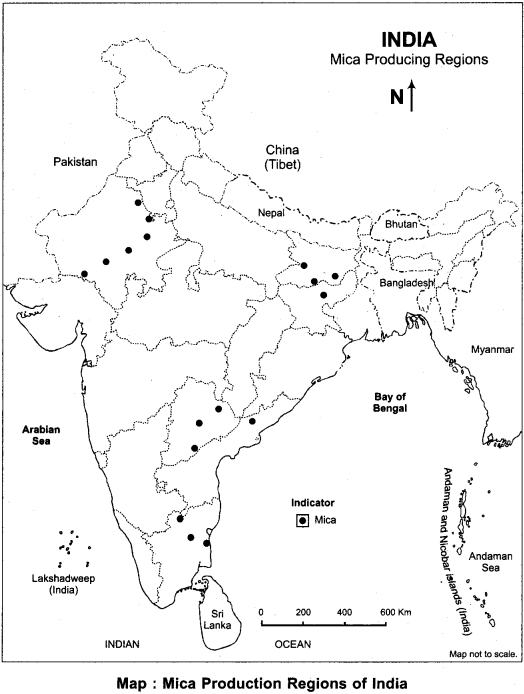Rajasthan Board RBSE Class 12 Geography Chapter 16 Biotic and Non-biotic Resources
RBSE Class 12 Geography Chapter 16 Text Book Questions
RBSE Class 12 Geography Chapter 16 Multiple – Choice Questions
Question 1.
What is the place of India in the world in cow rearing?
(a) Second
(b) First
(c) Third
(d) Fourth
Answer:
(a) Second
Question 2.
What is the percentage of buffaloes of the world reared in India?
(a) 40%
(b) 56%
(c) 48%
(d) 42%
Answer:
(b) 56%
Question 3.
In which state of India are most number of camels reared?
(a) Gujarat
(b) Punjab
(c) Haryana
(d) Rajasthan
Answer:
(d) Rajasthan
Question 4.
In India on how much part of geographical area forests are found?
(a) 22%
(b) 21.34%
(c) 14%
(d) 19%
Answer:
(b) 21.34%
Question 5.
In which state highest percentage of land is under forest?
(a) Mizoram
(b) Meghalaya
(c) Arunachal Pradesh
(d) Himachal Pradesh
Answer:
(a) Mizoram
Question 6.
The forest found in the area where rainfall is less than 50 cm:
(a) Dry
(b) Desert
(c) Monsoon
(d) Evergreen
Answer:
(b) Desert
Question 7.
What is the form of vegetation found in Western Ghats?
(a) Evergreen
(b) Alpine
(c) Savanna
(d) Deciduous
Answer:
(a) Evergreen
Question 8.
Tropical wet evergreen forests are found in:
(a) Aravalli mountain range
(b) Shillong Plateau
(c) Peninsular Plateau
(d) Shivalik range
Answer:
(b) Shillong Plateau
Question 9.
Oyster culture is being developed on:
(a) Saurashtra coast
(b) Mumbai coast
(c) Cochin coast
(d) Chennai coast
Answer:
(a) Saurashtra coast
Question 10.
India’s longest river is:
(a) Brahmaputra
(b) Ganga
(c) Yamuna
(d) Krishna
Answer:
(b) Ganga
Question 11.
In which sector is surface water used the most?
(a) Agriculture
(b) Industry
(c) Domestic
(d) others
Answer:
(a) Agriculture
Question 12.
Neeru/Meeru programme is being run in:
(a) Rajasthan and Bihar
(b) Madhya Pradesh and Rajasthan
(c) Bihar, UP and Rajasthan
(d) Odisha, Rajasthan, Bihar and UP
Answer:
(b) Madhya Pradesh and Rajasthan
Question 13.
Copper is produced in:
(a) Rajasthan
(b) Andhra Pradesh
(c) Gujarat
(d) Karnataka
Answer:
(b) Andhra Pradesh
Question 14.
Which mineral is dug out from the Babubadan hills situated in Karnataka state?
(a) Iron ore
(b) Manganese
(c) Nickel
(d) Petroleum
Answer:
(a) Iron ore
Question 15.
Which Indian state produces the highest quantity of mica?
(a) Andhra Pradesh
(b) Bihar
(c) Jharkhand
(d) Rajasthan
Answer:
(a) Andhra Pradesh
Question 16.
In India, the mica mining center is:
(a) Khetri
(b) Koderma
(c) Kalahandi
(d) Gurumahisani
Answer:
(b) Koderma
Question 17.
The iron – ore found in Bailadilla is:
(a) Hematite
(b) Siderite
(c) Limonite
(d) Magnetite
Answer:
(a) Hematite
Question 18.
In which Indian state is the highest quantity of iron ore found?
(a) Goa
(b) Chattisgarh
(c) Odisha
(d) Karnataka
Answer:
(d) Karnataka
Question 19.
With which minerals is Balko associated?
(a) Aluminium
(b) Gold
(c) Copper
(d) Zinc
Answer:
(a) Aluminium
Question 20.
Which state is prominent in copper production?
(a) Jharkhand
(b) Rajasthan
(c) Madhya Pradesh
(d) Karnataka
Answer:
(c) Madhya Pradesh
Question 21.
Which of these is the major mines of bauxite?
(a) Jawar
(b) Khetri
(c) Lohardagga
(d) Kalol
Answer:
(c) Lohardagga
RBSE Class 12 Geography Chapter 16 Very Short Answer Type Questions
Question 22.
What per cent animals of the world are found in India?
Answer:
Almost 20%.
Question 23.
Which animal is reared for wool and meat?
Answer:
Sheep is reared for wool and meat in India.
Question 24.
Which is the most important construction wood obtained from monsoon forest?
Answer:
Sagwan and Sal.
Question 25.
How many people have gained employment from fisheries in India?
Answer:
1.14 crore people.
Question 26.
On what per cent part forest is found in India at present?
Answer:
On 21.34% part according to 2015.
Question 27.
What are major areas for fish catching?
Answer:
Sea coast area, Ganga, Brahmaputra, Hooghly, Mahanadi, Godavari, Krishna, Kaveri, internal parts of the country and freshwater bodies.
Question 28.
What is the average annual rainfall in India?
Answer:
108 cm.
Question 29.
What are the major sources of irrigation in India?
Answer:
Canals, tubewells, wells, tanks and dams.
Question 30.
What is the meaning of minerals?
Answer:
All those natural materials which are dug out from the earth’s surface for commercial use are called minerals.
RBSE Class 12 Geography Chapter 16 Short Answer Type Questions
Question 31.
Why is the camel called the Ship of the Desert?
Answer:
The camel can be reared easily in dry and hot areas and it can survive for seven days without water in extreme heat. In sandy desert area, it can run fast due to its padded feet and can move up to 50 km in a day. The camel has excellent memory and does not forget the way for years. In sandy and desert parts, there is no alternate of camel as means of transportation. That is why it is called the Ship of the Desert.
Question 32.
Write down the names of major domesticated animals found in India.
Answer:
Major domesticated animals found in India are cow, bull, buffalo, goat, sheep, horse, mule, donkey, pig, etc.
Question 33.
What is the importance of animal resource in India.
Answer:
In India animal resource contributes in different works as such agriculture, milk production, leather production, compost making, transportation, providing meat and different artistic things are also obtained from the horns. In India, the animals are used in transportation and agricultural work. That is why these are of much importance.
Question 34.
What do you mean by non – metallic minerals?
Answer:
The minerals in which no trace of metal is found are called non – metallic minerals, such as – mica, asbestos, pyrite, salt, diamond, building stones, lime stone and rock phosphate, etc.
Question 35.
Describe major irrigation resources in India.
Answer:
In India canals, tubewells, wells and tanks are major sources of irrigation. Among these, maximum irrigation is done by tube wells and canals. In north India, irrigation is done by canals, wells and tubewells, while in south India, irrigation is done chiefly by tanks and canals.
Question 36.
Describe copper producing areas of India.
Answer:
Following are the areas:
- Balaghat (Malajkhand), Toregaon and Betul districts of Madhya Pradesh.
- Khetri and Singhana in Jhunjhunu district of Rajasthan.
- Singhbhum, Hazaribagh, Santhal paragana and Manbhoomi districts of Jharkhand.
RBSE Class 12 Geography Chapter 16 Essay Type Questions
Question 37.
Describe the products obtained from animals in India and also mention the causes of their weak health.
Answer:
Products obtained from animals in India:
Following are the products:
- In India, milk is obtained from animals on large scale and from milk, khoya, cheese, butter, buttermilk, ghee and milk powder are made.
- Compost is made from animal dung, urine and bones.
- Leather and wool is obtained from animals in India, which is used for making different useful things.
- At present, in India, almost 4000 slaughter houses are working in which billions of rupees of meat and other meat products are produced.
- From the horns of animals, several decorative things are made.
Cause of weak health of animals in India:
In India, the animals give less milk and meat. Following four factors are responsible for it:
1. Lack of healthy food and green fodder:
Due to large population, food grains are chiefly grown in India while the farmers pay little heed to production of green fodder. Besides, there is lack of green pastures. That is why the farmers do not feed their cattle sufficient and nutritious diet. Consequently, the animals grow weak and give less milk and meat.
2. Lack of good breed:
Animals of good breed are not available in India. Although the government is opening animal reform centers, breeding centers and medical centers in villages, yet desired results are not coming.
3. Diseases of animals:
Due to the unhealthy living atmosphere, polluted water and rotten things and living in touch with sick animals, several animals become ill. During rainy season, in different parts of India, animals die in large number due to infection in mouth, feet, poisoning, fever and infection of throat.
4. Ignorance and carelessness of animal rearers:
In India, most of animal rearers rear animals in traditional way and they do not have knowledge of modern methods of animals rearing, besides, they are careless towards the health of animals. Although in some parts of India, modern dairies have been established.
Question 38.
Describing the causes of decreased forest area in India, mention the demerits caused by deforestation.
Answer:
In India, according to the new forest policy, there should be forest cover on 33% of total land part, but upto 2015 only 21.34% land part was under the forests cover.
Main causes of decreasing forest area in India:
Following are the causes:
1. Growth of continuous demand of agricultural land:
For sustenance of rapidly growing population of India, the need to increase food grain production is felt. For the expansion of agricultural land, forests are being cleared on large scale, and consequently, the forest area is decreasing.
2. Rapid industrialization and urbanization:
After independence, for industrialization and urbanization, industrial buildings, residential colonies, commercial area, offices, administrative blocks, roads and railway tracks were made. Recently Many Express and Super Express Ways Airports etc. are being constructed for fast development work. For these, forests were cleared in past and are being cleared in present time on large scale.
3. Deforestation for domestic use:
Deforestation is being done for furniture, building construction etc.
4. Uncontrolled grazing:
Due to uncontrolled grazing, small plants and grasses are eaten up and destroyed by the animals hooves. It causes soil erosion which is a major cause of deforestation.
5. Shifting agriculture:
In India, shifting agriculture is being practiced by some tribes. In it, agricultural land is prepared by cutting and clearing the forests. Farming is done for 3 to 4 years on such land and this process is repeated elsewhere. Thus, forest areas are decreasing due to this traditional practice.
6. Other causes:
Development of multipurpose projects, increasing mining areas, violation of government rules and different diseases of plants are other causes.
Demerits of deforestation:
Following are the demerits:
- Rainfall is reduced due to deforestation and aridity increases.
- Due to this, the industries based on forest are becoming destroyed and unemployment is increasing and national income is decreasing.
- Flow of river water increases and danger of flood and soil erosion increases.
- Underground water level decreases and shortage of fodder for animals appears.
- Results shortage of timber and fire wood.
- Storms blow unobstructructed, causing soil erosion. Expansion of deserts increases.
- Carbon dioxide level rises in the atmosphere, thereby increasing the risk of global warming.
- Air pollution increases as a result of which humans have to face and suffer from many ailments.
- Forest destruction leads to ecological imbalance.
- There is widespread destruction of wildlife, many wildlife species have become extinct.
Question 39.
Clarifying importance of forest resources in India, describe the types of forests.
Answer:
Importance of forest resources:
Civilization and human development originated from the forests. The forests are national property. The forests provide shelter, food and employment. The importance of forest resources can be understood through its direct and indirect advantages:
Direct Advantages:
- 2% of total national income of the country is obtained from the forests.
- 2.5 crore tribals live in forests and their livelihood depends on forests.
- Lakhs of people get employment from the forests.
- Nearly 5.5 crore animals use forests as grazing lands.
- Major timber such as saal, sagvan, shesham, devdar and pine trees are found in forests which are used in making furniture, agricultural implements or tools, railway coaches, vehicles and as fire wood.
- For several industries, raw material is obtained from the forest such as- paper, match, silk, lac, furniture, plywood, packaging and toy industries.
- Several products from the forests such as – gum, bamboo, turpentine oil, fruits, flowers, leaves, biroja, leather coloring materials are obtained.
- Precious herbs such harar, bahera, amla and several others are obtained from the forests.
- Forests provide shelter and food to wild animals.
Indirect Profit:
- Forests help in bringing rain.
- Forests reduce temperature and make the climate mild and reduce greenhouse effect.
- Forests reduce soil erosion and reduce the effect of floods.
- Forests increase underground water level.
- Forests reduce the speed of storms and fast winds.
- Forests increase soil fertility by increasing quantity of mico – rorganisms and humus in the soil.
- Forests control air and noise pollution, they absorb carbon dioxide and release oxygen. Besides exchange of gases in nature goes on without any obstruction.
Types of Forests:
Due to huge size of India, differences are seen here in relief, climate and soil and that is why six types of forests are found in the country.
1. Tropical evergreen forests:
These are found in those parts of India, where annual rainfall is more than 200 cm and temperature is 28° centigrade. Tropical evergreen forest are found here. In India, such forests are found in three regions:
- North – eastern India and in Lower Himalayas.
- Western slopes of Western Ghats.
Andaman and Nicobar islands:
The wood of these forests is hard and due to their dense growth, sunrays do not reach upto the ground. In these forests, trees of different species are found jointly.
Main trees:
Mahogany, gataparcha, Ebony, loh kasht, toon, rubber, cinchona, bamboo, saal, gurjan, bamboo, chaplus and tulsar.
2. Monsoon or autumn forests:
This kind of forest is found where average annual rainfall is from 100 to 200 cm and temperature remains between 26°C to 31°C. These forests shed their leaves before summer season. That is why these are called antumn forests. These forests can easily be exploited due to their less dense growth.
In India, main regions of such forests are the following:
- Outer and lower slopes of Himalayan mountain range.
- In Madhya Pradesh, in Jharkhand, Chhattisgarh, Odisha and central India.
- Eastern slopes of Western Ghats.
- Southern parts of Eastern Ghats.
Main trees:
Shisham, sal, sagwan, sandal, rosewood, bamboo, palash, haldu, mango, ebony, mahua, pipal, banyan, cottonwool (semal) and Khair.
3. Tropical dry forests:
Such forests are found in areas where annual average rainfall is from 50 cm to 100 cm and temperature is between 20°C to 35°C. In India, there are two regions of such forests:
- In north – west India south – west Punjab, Haryana, eastern Rajasthan, Aravalli mountains and south – western Uttar Pradesh.
- Dry areas of south peninsular regions. The roots of these trees are long, leaves are thick, and trunk is rough. Main trees are babool, neem, mango, jamun, khejri, banyan, kikar and mahua, etc.
4. Desert forests:
In India, these forests are found where average rainfall is less than 50 cm and the temperature is from 25°C to 35°C. These forests are found in south – western Punjab, western Rajasthan and Gujarat state. The roots of these trees are thick and long, leaves are thick, small and thorny. The number of bushes are more. Trees are found at distance and in small numbers.
Main trees:
Cactus, kair, khair, kejra, dates, babool, neem, pipal, banyan and rambas etc.
5. Mountain forests or temperate evergreen forests:
In India, these forests are found in eastern Himalayas, western Himalayas, hills of Assam, Mahabaleswar hills of Maharashtra. The leaves of these trees are dense and stem is thick, bushes are found below the trees.
Main trees :
Chir, sanovar, deodar, fir, spruce, larch, maple, elm, chestnut, ujenia, micholia and rhododendron trees are found in high mountainous areas.
6. Tidal or marshy forests:
These forests are chiefly found in deltaic areas of Ganga – Brahmaputra and Hooghly rivers and at the mouth of Krishna, Kaveri, Mahanadi, and Godawari and in coastal areas. Due to tides, the roots of these trees remain submerged in sea water and the branches of the roots spread in all direction. The wood of these trees is soft.
Main Trees:
In Deltaic part of the Ganga and Brahmaputra and Hooghly rivers, the tree sundari is found in large numbers.
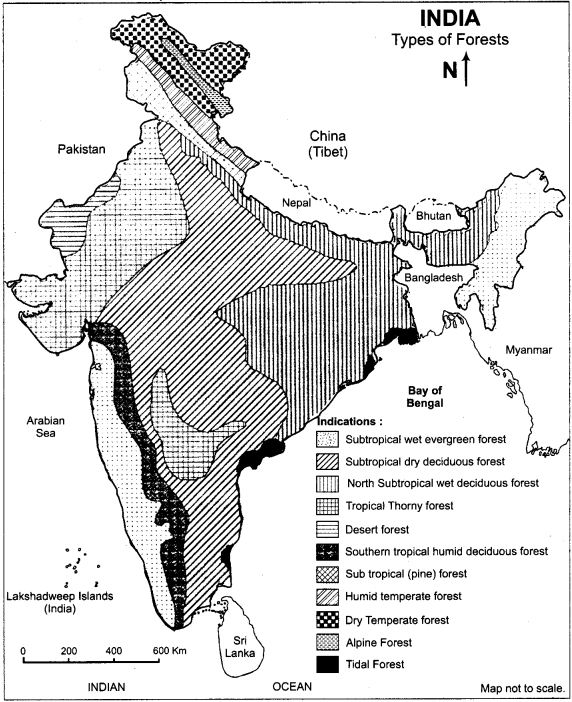
Question 40.
Write a note on the fisheries industry of India.
Answer:
In India, the fish are caught in only 25% part of fish production area. 60% of total fish production of India is obtained from oceans and about 40% is obtained from inland water bodies. 70% of total ocean fish are obtained from western coastal area and 30% from eastern coastal area.
Importance of fish industries in India:
- This food is rich in protein and makes a balanced diet and protects us from malnutrition.
- More than one crore people get employment from this occupation.
- Foreign currency is obtained from this occupation.
- Many allied industries such as – boat making, fishing equipment, carton, oil – extraction and compost making business are also developed.
Major fishing areas of India:
Following are the five main regions:
1. Seacoast area:
This fish area is developed on sea coastline upto 100 km in the open sea. Most fish of this area are caught in wide open sea upto 40 km. Shark, mackerel, akaki, sardine, ole, catfish, tuna, herring, shrimp and mullet are the main.
2. River mouth sea area:
Fish are caught at the mouth of Ganga, Brahmaputra, Hooghly, Mahanadi, Godavari, Krishna and Kaveri for 6 – 9 months of the year. Perch, ap, kark, katla, catfish, rehu, hilsa, pomfret, and oyster are the main fish.
3. Freshwater fishing area:
In India freshwater fish are caught from rivers, tanks, dams, lakes, ponds. The fish are also caught from the flowing water of the Ganga, Brahmaputra, Mahanadi, Narmada, Godavari, Krishna, Kaveri and their tributaries.
4. Oyster area:
In the sea part of India, in wide Gulf of Kutch, coastal sea of Saurashtra, Gulf of Mannar and the sea part near Pamban island of Tamil Nadu, the oyster fish are caught, from which pearl is obtained by injecting a chemical in them.
5. Shell fish area:
These fish are found in Tamil Nadu, Kerala and at the depth of 13 meters of sandy land of Saurashtra coast of Gujarat, these fish are caught from October to May. Their shells are used in temples and other decorative things.
Production:
In the production of fish, India occupied second place after China.
According to 2012 – 13, the highest fish producing states are:
Andhra Pradesh (18.08 lakh tons), West Bengal (14.09 lakh tons), Gujarat (7.86 lakh tons), Kerala (6.33) lakh tons, Tamil Nadu (6.20 lakh tons), Maharashtra (5.79 lakh tons), Karnataka (5.75 lakh tons) and Odisha (4.10 lakh tons).
Chief fishing centers are shown in the following map:
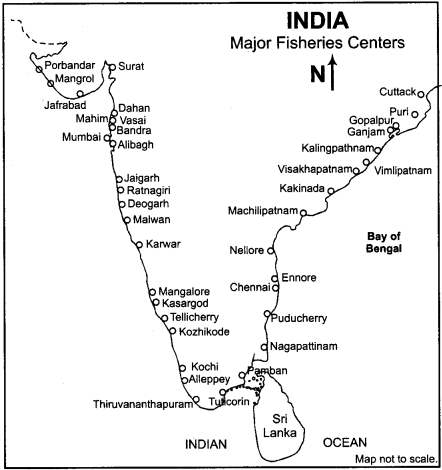
Question 41.
Write a short note on the availability of water resources and their use in India.
Answer:
Water is a necessary, limited and a highly sensitive cyclic resource. No human activity and environmental process is possible without water.
Availability of water resources in India:
Water is a cyclic resource available on the earth in sufficient quantity. Only 3% of total available water on the earth is potable and the rest 97% is not useful due to salinity. In India, only 4% of world’s non – saline water is found, while 17.5% population of the world lives here.
In India there are two sources of water:
- Surface water
- Underground water
1. Surface water availability and use:
The water which is obtained from the rivers, lakes, tanks and dams through rain is called surface water. In rainfall, rain and snowfall is included, but rain is the main source of surface water. The average annual rainful in India is 108 cm, 4000 cubic m water is obtained through rainfall out of which 1869 cubic m is received in the form of surface water through rivers, lakes, ponds, dams and other reservoirs, while 1341 cubic m is absorbed in the form of water vapour and moisture in soil.
The remaining 790 cubic m is absorbed by the land. Out of 1869 cubic m surface water, only 690 cubic m river water can be used for irrigation. But due to lack of technical competency, only 60% part of this water capacity is used for irrigation purposes.
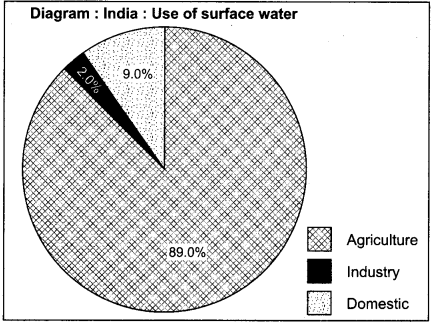
In context to the total water received from Indian rivers, the contribution of different rivers in it is given below:
- Himalayan rivers (Indus, Ganga and Brahmaputra) – 60%
- South Indian rivers (Godawari, Krishna and Kaveri) – 24%
- Rivers of central India (Narmada, Tapti and Mahanadi) – 16%
In India, from the total water received from rivers, lakes, ponds and canals, 89% is used in Agriculture, 9% in domestic work and rest 2% in industrial works. The saline water of lagoon lakes associated with coastal areas of India is used for fisheries and for irrigation of special species of coconut and rice.
2. Underground water availability and use:
In India, through rainfall every year, 790 cubic cm water is obtained in the form of underground water. But out of this, total quantity of underground water, use of only 225 cubic m water is possible from economic point of view. But from this underground water reserve, only 7 8 cubic m underground water is used for irrigation. In India, 92% underground water is used in agricultural works, 5% in industries and rest 3% is used in domestic works.
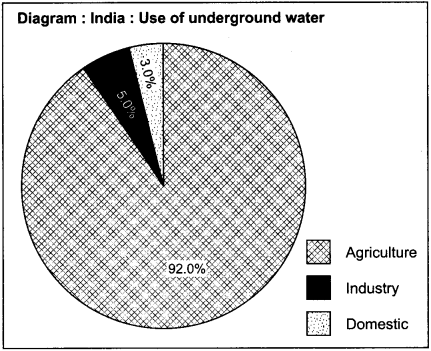
Of the total underground water available in India, 44% part is found in the cracks of rocks in Sutlaj – Ganga – Brahmaputra basin. This is why due to adequate reserves of underground water, tubewells and wells are found in abequate number in Punjab, Haryana, Uttar Pradesh, Bihar and West Bengal. In South peninsular plateau parts of the country where igneous and metamorphic rocks are found, presence of underground water is limited only to rocks joints.
Question 42.
What is the importance of iron in modern age? Describe distribution, production and trade of iron in India on a map.
Answer:
Importance of Iron in Modern Age:
In modern age, iron is the axis of economic development of any country. Iron is mainly used in building construction, vehicles, machines, huge engines, railway tracks and furniture. Different types of steel is manufactured by mixing manganese, tungsten, and nickel in iron. Due to excessive use of iron, present age is called the age of Iron and Steel.
Distribution and Production:
In India, production of iron ore is done mainly in Karnataka, Odisha, Chhattisgarh, Goa and Jharkhand states, while Maharashtra, Andhra Pradesh and Tamil Nadu etc. are other iron ore producing states.
1. Karnataka:
In iron ore producing states of the country, the position of Karnataka is the first. At present, this state is producing 25% iron – ore of the country each year. In this state, hematite variety of iron ore is found. Major areas of iron ore production of this state include Kadar (Bababudan hills), Bellari, Hospet, Shimoga, Dharwar, Tumkur, Chikmagalur and Chitradurga districts.
2. Odisha:
It occupies second place after Karnataka. At present this state is producing 22% iron of the country. Major producing districts of this state are Mayurbhanj (Guru mahisani, Sulepat and Badam hills) Sundergarh, Bonai, Sambalpur and Cuttack. In this state, Hematite type of iron ore is produced.
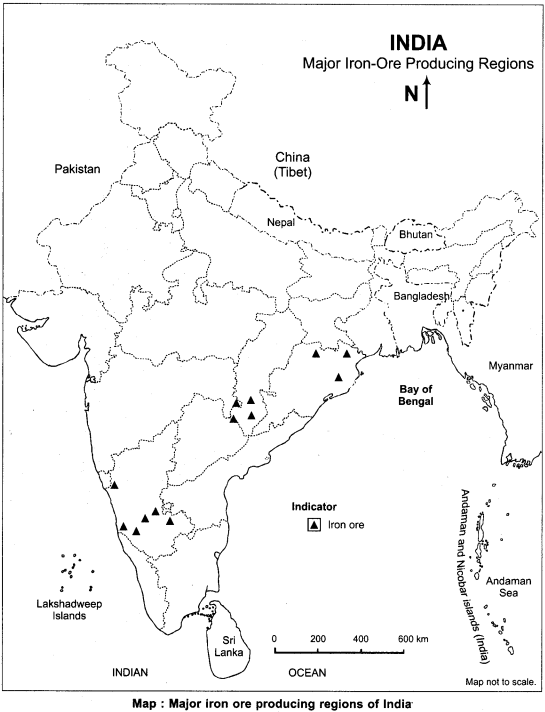
3. Chattisgarh:
20% iron – ore of the country is produced in this state and this state occupies the third place. Bastar and Durg are the major producing districts of this state. In Bastar district, Bailadilla – Raoghat range and in Durg districts Dalhi – Rajhara mines are the important iron ore mines.
4. Goa:
It produces 18% iron ore of the country. Mima, Adola Pale, Onda, Kudnam, and Princesalem are the major iron ore producing districts. In this state, poor quality of iron ore (iron part up to 50%) is produced.
5. Jharkhand:
It produces 14% iron ore of the country. Singhbhum (Noamandi), Matrubhoomi and Hazaribagh are the major iron ore producing districts.
6. Maharashtra:
In this state Pipalgaon, Lohar, Deval village and Chandrapur district are the main iron ore producing areas.
7. Andhra Pradesh:
Adilabad, Karim nagar, Nizamabad, Krishna, Kurnool, Cuddapah, Gantur, Nellore, Chittoor and Warangal districts.
8. Tamil Nadu:
Salem, Tiruchirappalli and Nilgiri districts.
Iron – ore production:
In the year 2001 – 02, 7.4 crore tons, in 2010 – 11, 22.5 crore tons and in 2013 – 14, 15.24 crore tons iron – ore was produced in India.
Trade:
In 2010 – 11, from India, iron – ore worth 214.2 billion rupees was sent to foreign countries. The countries where iron ore was exported from India include Japan as the major importer (8% of total export) and other countries including Czechoslovakia, Germany, Romania, Italy, Poland, Belgium, and Hungary.
Question 43.
Classifying the utility of aluminium, and give a diagrammatic representation of the distribution and trade of bauxite in India.
Answer:
Utility of aluminium:
Aluminium is a multipurpose, light, soft, flexible and good conductor of electricity metal which is mainly used in making electric wires, satellites, aircraft, missile, floor sheet of ship, spare parts, utensils, doors of buildings, windows, shutters etc.
Distribution and Production of Bauxite in India:
1. Odisha:
50% bauxite of the country is produced in this state. It occupies the first place in production. The bauxite mines in this state have 62.5% part of bauxite. Kalahandi and Sambalpur are the major producing districts. While the Gandhmardan pleateau of Bolangir and Koraput districts is emerging rapidly in the field of mining.
2. Jharkhand:
It has second place in bauxite production, (almost 12% of the country). Ranchi, Palamu, Giridih, Lohardagga, Shahabad, and Gumla are the major bauxite producing districts.
3. Gujarat:
In this state, the reserve of 5 crore tons of bauxite is estimated. Bhavnagar and Jamnagar are the main producing districts, while Sabharkantha, Surat, Kheda and Porbandar are other bauxite producing districts.
4. Maharashtra:
It occupies 4th place in bauxite production Kolhapur, Colaba, Thane, Satara, Ratnagiri and Pune are the major bauxite producing districts.
5. Chattisgarh:
It occupies 5th place in bauxite production and contributes 6% of the bauxite production of the country. It occupies 1st place in producing best quality bauxite and has bauxite reserves of 30 – 35 crore tons. Sarguja, Ramgarh, Mahasamar, ICorba, Rajnandgaon, and Bilaspur, are the major bauxite producing districts.
6. Tamil Nadu:
Salem, Madurai, Nilgiri, Coimbatore are major bauxite producing districts. It occupies 6th place in India.
7. Madhya Pradesh:
Shahadol, Mandla, Katni, Balaghat, Jabalpur and Seoni are major bauxite producing districts of this state.
8. Karnataka:
Belgaum, south Canara districts and Bababoodan hills.
9. Andhra Pradesh and Telangana:
Visakhapattnam, Vijaynagar and Srikakulam districts.
Trade:
In India, in 2001 – 02, bauxite production was 85.85 lakh tons, in 2005 – 06 it was 123.35 lakh tons and in 2013 – 14 it was 217 lakh tons. So, India exports to European countries and Russia best quality semi-prepared alumina metal. 80% part of bauxite production of bauxite is taken from aluminium alone.
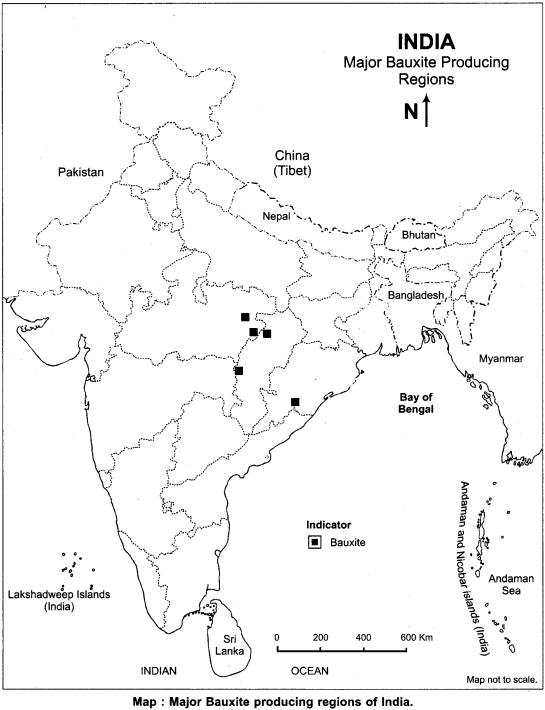
RBSE Class 12 Geography Chapter 16 Additional Questions with Answer
RBSE Class 12 Geography Chapter 16 Multiple Choice Questions
Question 1.
From sheep rearing point of view, India’s place is:
(a) First
(b) Second
(c) Third
(d) Fourth
Answer:
(b) Second
Question 2.
In which Indian state, jhooming agriculture is done?
(a) Jharkhand
(b) Himachal pradesh
(c) Nagaland
(d) Jammu – Kashmir
Answer:
(c) Nagaland
Question 3.
In which area tropical evergreen forests are not found?
(a) North – east India
(b) Andaman and Nicobar islands
(c) Western Ghats
(d) Eastern Ghats
Answer:
(d) Eastern Ghats
Question 4.
Which of the following trees is not associated with desert forest?
(a) Shisham
(b) Date
(c) Babool
(d) Khejari
Answer:
(a) Shisham
Question 5.
Sundari trees are mainly found in:
(a) deltaic part of Hooghly river
(b) Godavari deltaic part
(c) Kaveric deltaic part
(d) Krishna deltaic part
Answer:
(a) deltaic part of Hooghly river
Question 6.
National tree of India is:
(a) Pipal
(b) Arjun
(c) Devdar
(d) Ashok
Answer:
(d) Ashok
Question 7.
In India on how much part of available fisheries production area the fish are caught?
(a) 25%
(b) 30%
(c) 35%
(d) 40%
Answer:
(a) 25%
Question 8.
In which area the work of catching Shell fish is done?
(a) Chilka lake
(b) Gulf of Khambat
(c) Saurashtra’s eastern coast
(d) Saurashtra’s western coast
Answer:
(d) Saurashtra’s western coast
Question 9.
Which Indian region is rich in reserves of underground water?
(a) Western coastal area
(b) Eastern coastal area
(c) Sunderban deltaic area
(d) Sutlej – Ganga – Brahmaputra basin
Answer:
(d) Sutlej – Ganga – Brahmaputra basin
Question 10.
Haryali project is associated with
(a) Fisheries
(b) Afforestation
(c) Water management
(d) All these
Answer:
(d) All these
Question 11.
Water management project named Arvari Water Parliament is associated with the state:
(a) Rajasthan
(b) U.P.
(c) Maharashtra
(d) Kerala
Answer:
(a) Rajasthan
Question 12.
The water storage structure in Rajasthan is called:
(a) Johad
(b) Lake
(c) Well
(d) Tank
Answer:
(a) Johad
Question 13.
In which of the following states water storage structure is necessary for building construction?
(a) Andhra Pradesh
(b) Maharashtra
(c) Tamil Nadu
(d) Odisha
Answer:
(c) Tamil Nadu
Question 14.
Which are leading states in iron – ore production?
(a) Chhattisgarh – Jharkhand
(b) Karnataka – Odisha
(c) Odisha – Goa
(d) Karnataka – Jharkhand
Answer:
(b) Karnataka – Odisha
Question 15.
In India, highest bauxite producing state is:
(a) Jharkhand
(b) Odisha
(c) Gujarat
(d) Maharashtra
Answer:
(b) Odisha
Question 16.
Which of these ores is produced chiefly in Kalahandi and Sambalpur districts?
(a) Copper
(b) Iron
(c) Bauxite
(d) Mica
Answer:
(c) Bauxite
Question 17.
Which of these is the leading state in mica production?
(a) Andhra Pradesh
(b) Rajasthan
(c) Jharkhand
(d) Tamil Nadu
Answer:
(a) Andhra Pradesh
Question 18.
Which of these has the first place in goat rearing in the world?
(a) Brazil
(b) India
(c) China
(d) Australia
Answer:
(b) India
Matching the Following
Match the option given in Column A to correct option given in Column B:
A.
| Column A (Species) | Column B (Domestic Animals) |
| I. Tharparkar | A. Sheep |
| II. Jafrabadi | B. Camel |
| III. Nachna | C. Goat |
| IV. Jakhrana | D. Cow |
| V. Chokla | E. Buffalo |
Answer:
I – D, II – E, III – B, IV – C, V – A.
B.
| Column A (Species) | Column B (Types of Forests) |
| I. Gataparcha | A. Tidal forest |
| II. Rosewood | B. Tropical forest |
| III. Cactus | C. Monsoon forest |
| IV. Deodar | D. Desert forest |
| V. Reetha | E. Mountain forest |
| VI. Sonerita | F. Evergreen forest |
Answer:
I – F, II – C, III – D, IV – E, V – B, VI – A
C.
| Column A (Mineral name) | Column B (Producing Region) |
| I. Iron – ore | A. Khetri |
| II. Copper | B. Kalahandi |
| III. Bauxite | C. Nellore |
| IV. Mica | D. Bailadilla |
Answer:
I – D, II – A, III – B, IV – C
RBSE Class 12 Geography Chapter 16 Very Short Answer Type Questions
Question 1.
Into how many parts are the resources divided on the basis of their origin?
Answer:
These are divided into two parts:
biotic and abiotic resources.
Question 2.
How did Dr Darling describe the importance of Indian animal wealth?
Answer:
According to him, “The fields remain unploughed, Farm land remains empty for want of food crops and lack of animals, there may be scarcity of milk, butter, cheese and other animal products”.
Question 3.
Why is the dependence on animals decreasing in India?
Answer:
It is decreasing due to the use of tractors, harvesters, pumps, canals, sufficient electric supply and increasing facilities of transportation.
Question 4.
In hilly regions, which animals do not have their alternative?
Answer:
Pony, donkey and mule do not have their alternatives in hilly areas.
Question 5.
What is the number of slaughter houses in India.
Answer:
Nearly 4000.
Question 6.
What are major areas of animal rearing in India?
Answer:
Himalayan hilly region, north – west climatic area, eastern and western coastal area and the regions of medium rainfall.
Question 7.
Which breeds of buffaloes are found in India?
Answer:
Murrah, Jafrabadi, Bhadavari, Surti, Neli, Mehsana, etc. are the main breeds.
Question 8.
Where are goats reared in India?
Answer:
Goats are mainly reared in Rajasthan, U.R, Punjab, Gujarat, M.P., Karnataka, Tamil Nadu, Andhra Pradesh, Jharkhand, etc.
Question 9.
Where are sheep reared in India?
Answer:
Sheep are mainly reared in Rajasthan, Andhra Pradesh, Tamil Nadu, M.P, Karnataka, Himachal Pradesh, Punjab, Haryana, Uttarakhand and U.P.
Question 10.
What are the causes responsible for weak health position of animals in India?
Answer:
Lack of green fodder and nutritious food, lack of good breed, animal diseases, and ignorance and carelessness of animal rearers are the causes responsible for weak health position of animals in India.
Question 11.
What are evergreen forests? What is the ideal geographical conditions for them?
Answer:
The forests which remain green round the year are called evergreen forests. Such forests are found where rainfall is more than 200 cm and the temperature is upto 28°C.
Question 12.
What are the areas of evergreen forests in India?
Answer:
There are three major areas of such forests- north east India and lower Himalayan areas, western slope of Western Ghats and Andaman and Nicobar islands.
Question 13.
Write the names of major tree species of evergreen forests.
Answer:
Main tree species are – Loh, Kashta, Mahogany, Gataparcha, Ebony, Tune, Coconut, Teak, Rubber, Cinchona, Bamboo, Sal, Wild mango, Tulser, Baint, Chaplas, etc.
Question 14.
What are the autumn forests?
Answer:
The forests which shed their leaves in the beginning of summer.
Question 15.
Write the names of major tree species of moonsoon forest.
Answer:
Major tree species are:
Sagwaan, Sal, Shisham, Rosewood, Kusum, Bamboo, Palash, Harar, Behri amla, Haldu, Ebony, Mango, Jamun, Sirus, Mahua, Pipal and Banyan, Khair, Semal and Gular.
Question 16.
Write the names of tree species of desert forests.
Answer:
In this species, cactus, kair, khair, khejari, date, babool, neem, pipal and banyan, rambans and thuar are included.
Question 17.
Where are the mountain forests situated mainly in India?
Answer:
These are found mainly in eastern and western Himalayas, Hills of Assam, Panchmarhi of M.P. and the Mahabaleshwar hills of Maharashtra.
Question 18.
Where are tidal forests found mainly in India?
Answer:
These are mainly found in the deltaic parts of Ganga – Brahmaputra and Hooghly rivers.
Question 19.
Write down the names of some tidal tree species.
Answer:
These are Bamboo, Palm, Bait, Coconut, Rosifera, Sonerita, Heritoaria and Phoenix.
Question 20.
Why is the forest area continuously decreasing in India?
Answer:
Increasing population, urbanization, industrialization and lack of general awareness among common people are causing this decline.
Question 21.
Where are training centers for catching fish in modern way established in India?
Answer:
These are in Kojan and Tutukundi in Tamil Nadu, Satpari in Maharashtra, Kochi in Kerala, Visakhapatnam in Andhra Pradesh and Vera in Gujarat.
Question 22.
Name two Indian states of highest fish production in India.
Answer:
Andhra Pradesh and West Bengal.
Question 23.
What are water resources?
Answer:
All water reserves found on surface and under the ground, which are useful to human beings are called water resources.
Question 24.
How much part of earth’s surface is covered with water?
Answer:
71% part of earth’s surface is covered with water.
Question 25.
How much part of the water on the land is non – saline?
Answer:
Only 3% part.
Question 26.
What are the water sources on the earth’s surface?
Answer:
The four major sources of water on the earth surface are – rivers, lakes, tanks and ponds.
Question 27.
How much water is obtained by river basins in India each year through rainfall?
Answer:
1869 cubic m water.
Question 28.
On what factor flow of river water depends?
Answer:
It depends on size factor of its catchment area.
Question 29.
The river basin area of which three rivers is developed on the one-third part of total area of India?
Answer:
In India Ganga, Brahmaputra, and Indus river basin area is developed on one-third area which has 60% of the total surface water resources.
Question 30.
Classify the use of groundwater.
Answer:
89% groundwater is used in agricultural work, 9% in domestic work and 2% in industrial work.
Question 31.
Write the use of lagoon and backwaters.
Answer:
This is used for fisheries, production of some certain type of rice and is also used for irrigation of coconut.
Question 32.
Which Indian states use maximum quantity of underground water?
Answer:
Punjab, Haryana, Rajasthan, Tamil Nadu are the main states.
Question 33.
Describe the use of underground water in different sectors.
Answer:
92% of underground water is used in agricultural work, 5% in industries and 3% in domestic works.
Question 34.
In which sector is ground and underground water used in much quantity?
Answer:
It is used in agricultural sector.
Question 35.
What is irrigation?
Answer:
Due to lack of rainfall in dry weather supply of water in an artificial way to grow crops, is called irrigation.
Question 36.
What is the greatest advantage of irrigation management?
Answer:
It makes possible the practice of multicropping system.
Question 37.
What do you mean by irrigation sources?
Answer:
Those sources which provide water to the fields for irrigation purposes such as – rivers, canals, tanks, lakes and dams, etc.
Question 38.
What do you mean by irrigation Instruments.
Answer:
The instruments which lift water from river, canals, lakes, dams, ponds, tubewells, wells are called irrigation Instruments.
Question 39.
Why has water scarcity emerged in India?
Answer:
Per capita availability of water is decreasing day by day due to continuous population growth in India. Due to the release of industrial, agricultural and domestic waste, water amount of clean water is reducing. Therefore, scarcity of water is emerging
Question 40.
What is the meaning of water quality?
Answer:
Water quality means purity of water or water without external contaminants.
Question 41.
What is main cause of increasing water pollution in India?
Answer:
Main cause is that industrial, agricultural and domestic wastes are mixed in fresh water bodies.
Question 42.
What do you mean by water pollution?
Answer:
When several unwanted materials are mixed in water, its quality declines and dangerous effects are seen on its use, such contamination is called water pollution.
Question 43.
What are the measures of water conservation?
Answer:
Reduction of water pollution, recycling, reuse, conservation and management of rainwater harvesting are included in water conservation.
Question 44.
Write down the names of major mineral belts of India.
Answer:
Jharkhand – Odisha – West Bengal belt, M.P. – Chhattisgarh – Andhra Pradesh – Maharastra, Karnataka – Tamil Nadu belt, Rajasthan – Gujarat belt, Kerala belt and Himalayan belt are major mineral belts in India.
Question 45.
What is position of India in the self-sufficiency of minerals in the world?
Answer:
In this regard, India occupies second place after USA.
Question 46.
What are metalic minerals? Give examples.
Answer:
The minerals which have metal constituents are called metalic minerals.
Example: iron ore, copper, gold and manganese.
Question 47.
What are non – metalic minerals. Give examples.
Answer:
The minerals which do not have any metalic constituents are called non – metalic minerals.
Example: limestone, dolomite, mica, etc.
Question 48.
Classify metalic minerals.
Answer:
- Ferrous minerals
- Non – Ferrous minerals.
Question 49.
What are ferrous – metalic minerals? Give examples.
Answer:
Those metalic minerals which have traces of iron metal are called ferrous metalic minerals.
Examples: iron – ore, manganese, tungsten and iron etc.
Question 50.
What are the types of iron ore in India?
Answer:
In India the types of iron – ore are – magnetite, hematite, limonite and siderite.
Question 51.
What are non – ferrous metalic minerals. Give examples.
Answer:
Those metalic minerals which do not have traces of iron metal are called non – ferrous metalic minerals.
Example: copper, bauxite, lead, zinc and silver, etc.
Question 52.
In which rock groups is hematite iron ore found?
Answer:
Dharwar and Cuduppah rock groups.
Question 53.
Which iron – ore is mainly excavated in Karnataka state?
Answer:
Hematite ore.
Question 54.
From which port, refined iron ore of Goa state is exported?
Answer:
Mormugao port.
Question 55.
To which country, India’s iron-ore is mostly exported?
Answer:
To Japan.
Question 56.
What is main use of copper?
Answer:
- It is mainly used in making electrical apparatus.
- It is mixed with gold to give strength to ornaments.
Question 57.
Name three major copper producing states.
Answer:
1. M.P.
2. Rajasthan
3. Jharkhand.
Question 58.
Write main use of bauxite.
Answer:
It is used mainly in making aluminium.
Question 59.
Which is the biggest bauxite producing state?
Answer:
Odisha.
Question 60.
Name the major bauxite producing areas of Odisha.
Answer:
1. Kalahandi
2. Sambalpur
3. Bolangir
4. Koraput.
Question 61.
What is the use of mica?
Answer:
It is used in making electrical appliances because it has excellent electrical resistance and high voltage tolerance.
Question 62.
Name major mica producing states in India.
Answer:
Andhra Pradesh, Rajasthan and Jharkhand are major mica producing states.
RBSE Class 12 Geography Chapter 16 Short Answer Type Questions (SA-I)
Question 1.
Describe camel rearing regions of India.
Answer:
Camels are very useful in desert area. At present, the number of camels is 4 lakhs in India, which is 2.4% of the world. The number of camels is more in Rajasthan. Here, 50% camels of the country are found. Other states where camels are reared are – Punjab, Haryana, Gujarat, U.P. and M.P.
Question 2.
Write a short note on the measures of animal resource development in India.
Answer:
Following are the important measures:
- Development of good pastures which can provide complete nutrition to animals.
- In rural areas at gram panchayat level, veterinary hospitals and artificial hybrid reproduction centers should be established to improve the breed of animals.
- Vaccines and medicines should be provided to save ailing animals from diseases.
- Scientific ways of rearing animals should be adopted.
Question 3.
Describe products obtained from Indian forests.
Answer:
Forest products can be divided into two classes:
1. Main Yields:
Wood of different trees are the main yield of Indian forests. The trees from which wood is obtained in India are deodar, pine, maple, fir, spruce, shisham, sanovar, saal, saagwan, sesam, mahua, chandan, semal, haldu, arjun, mango, khair, babool, bamboo, neem.
2. Less important yields:
These are lac, catechu, gum, mahua, tung, cane, rubber, fruit, honey, herbs, medicines, leather, coloring materials, turpentine oil, viroja, natural silk.
Question 4.
Write in brief the importance of forest resources.
Answer:
Following are the importance of forest resources:
- The birth of human civilization and its development took place from the forests.
- Forest resources directly or indirectly provide food, nutrition, employment, and also shelter to animal kingdom.
- Useful wood, medicines, herbs and fruits, flowers are obtained from the forests.
- Forests provide pastures to animals.
- Forests help in bringing rain and making the climate mild.
- Forests control expansion of desert and soil erosion.
- Forests increase soil fertility.
- Forests reduce effect of air pollution, noise pollution and greenhouse effect.
Question 5.
Describe major efforts which are being done for fisheries development in India.
Answer:
Major Efforts:
- Construction of special type of harbours are being done in fishing areas to increase the production.
- Modern fishing boats are being used to catch fish.
- Cold storage and drying units are being set up to keep the fish safe.
- On major railway routes, fast running freight trains with refrigerated coaches are being increased in number.
- Training centers for catching fish are being opened.
- Research centers are being opened for the search of new fish products.
- Use of trawlers is being done to catch fish in deep sea fishing areas.
- By establishing co – operative societies, facilities of selling and grants are being provided to fishermen.
Question 6.
Write the names of fishing ports in India and show major fishing centers on the map.
Answer:
Major fish ports of Eastern Coast:
Kolkata, Puri, Gopalpur, Ganjam, Kalingapattnam, Vimlipatnam, Kakinada, Machillipatnam, Nellore, Chennai, Puduchery, Nagapattinam and Tuticorin.
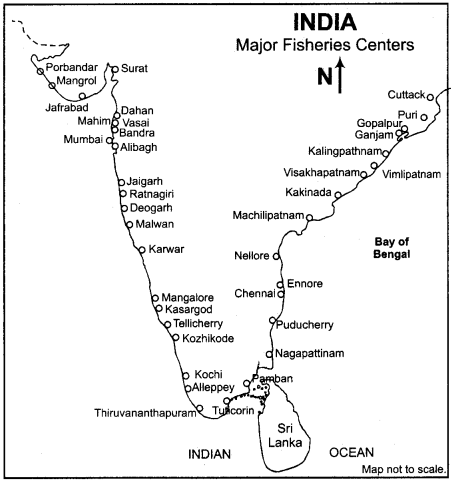
Major fishing ports of Western Coast:
Porbandar, Mangrol, Surat, Mahiiri, Mumbai, Jaigarh Ratnagiri, Devgarh, Malvan, Mangalore, Tellicherry, Kozhikode, Kochi, Alleppey and Tiruvananthapuram.
Question 7.
Describe the position of fish production in India and write the names of major fish producing states.
Answer:
In India, in 2001 – 02, 59.60 lakh tons, in 2012 – 13, 90.4 lakh tons, in 2013 – 14, 95.80 lakh tons fish was caught. It is clear that fish production is continuously increasing. In 2013 – 14, fish production in major fish producing states was as given below:
| State | Fish Production (2013-14) |
| Andhra Pradesh | 18.08 lakh tons |
| West Bengal | 14.09 lakh tons |
| Gujarat | 7.86 lakh tons |
| Kerala | 6.33 lakh tons |
| Tamil Nadu | 6.20 lakh tons |
| Maharashtra | 5.79 lakh tons |
| Karnataka | 5.75 lakh tons |
| Odisha | 4.10 lakh tons |
Question 8.
Give a brief description of the availability of surface water resources in India.
Answer:
There are four sources of surface water – river, lake, dams and tanks. Out of these, rivers are the main. The estimated annual water flow in all river basins is 1869 cubic m. Due to topography, water flow speed and other reasons, only near about 690 cubic m (32%) part is used by local people.
Ganga, Brahmaputra and Indus rivers are spread on almost one – third part of total area, which provide 60% water of the total surface water resources, while the rivers of central India (Narmada, Tapti and Mahanadi) provide 16% of total surface water resources and the rivers of south India (Godavari, Krishna and Kaveri) provide the remaining 24% surface water.
Question 9.
Describe briefly the utilisation of water in different sectors of India.
Answer:
Water utilization in different sectors of India:
Water is used in the following sectors:
1. Agricultural Sector:
In India, surface and underground water is mostly used in agricultural work. In this, surface water usage is 89% and underground water usage is 92%.
2. Industrial Sector:
In this, surface water usage is 24% and underground water usage is 5%.
3. Domestic Sector:
In this sector, surface water usage is more than underground water. Surface water usage is 9% and underground’s water usage is 3%.
Question 10.
Classify difference between surface water and underground water.
Answer:
Surface water:
Water present in various water sources available on the earth in the form of rivers, lakes, canals, tanks is called surface water. Its main source is the rivers.
Underground water:
The water found under the ground in the cavities and cracks of the rocks is called underground water. It can be obtained with the help of hand pumps, tube wells, wells and other sources.
Question 11.
Make a table of length and drainage system of major Indian rivers.
Answer:
Table:
Major Indian Rivers:
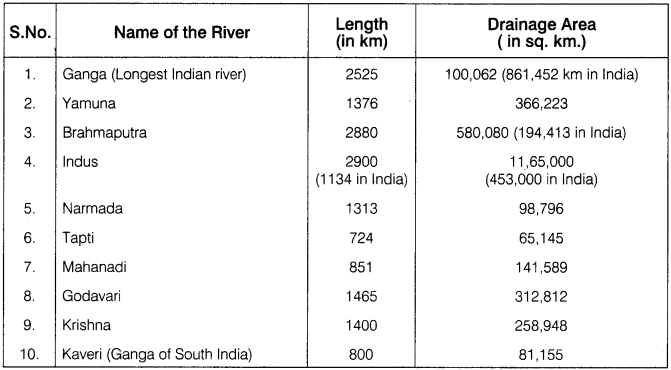
Source:
Indian Water Resource Information System.
Question 12.
What do you mean by Irrigation? Write a short note on the sources and equipments of irrigation.
Answer:
1. Meaning of irrigation:
Due to lack of rainfall in dry season, supply of water in an artificial manner to the fields to grow crops is called irrigation.
2. Source of irrigation:
The sources which help in providing water to the crops are called sources of irrigation, such as – rivers, canals, lakes, tanks, wells and tube wells, etc.
3. Equipments of irrigation:
The equipments with the help of which water is taken out of rivers, canals, lakes, dams, tanks, tubewells are called the implements/equipments, of irrigation, like rahat, chadas, dhenkuli, diesel pump, electric pump, etc.
Question 13.
Write major causes of the need of water resources for irrigation in India.
Answer:
Following are the main causes:
- For the need of higher agricultural production for growing population.
- Due to the uncertainty and irregularity of rain.
- Nature of rainfall and unequal distribution of rainfall.
- For the production of agricultural crops in dry area.
- To encourage intensive agriculture and multicroping system.
- To increase commercial crop production.
- More water is needed for hybrid and new crops.
- To solve the problem of drought.
- For pasture development.
Question 14.
Classify the surface and underground water resources for irrigation in India.
Answer:
The classification can be done in the following way:
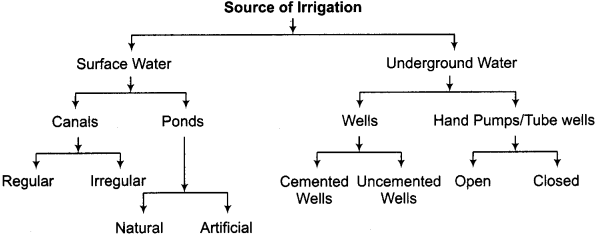
Question 15.
What do you mean by loss of water quality? Write down briefly the causes of water pollution.
Answer:
Water Pollution:
With addition of toxic material, microbes, chemical material and other unwanted material, water loses its natural quality and becomes so contaminated that it does not remain fit for use by human beings. This is called loss of water quality or water pollution.
Cause of Water Pollution:
Throwing waste and poisonous material regularly into water sources such as rivers, lakes and tanks, is the main cause of water pollution. These pollutants make the surface water polluted.
Question 16.
What do you mean by water resource management? Describe briefly the Hariyali Water Management Programme conducted by government.
Answer:
Mainly, better management of water resources of surface and underground water is called water resource management. These types of programs are being conducted by center, state and NGOs in which Hariyali Water Management Programme Project is included. The Hariyali project is being executed in rural areas by the government for drinking water, irrigation, fisheries, afforestation and forest conservation. This project is being conducted through the cooperation of rural people and gram panchayats.
Question 17.
Write main characteristics of minerals.
Answer:
Following are main characteristics of minerals:
- The minerals are naturally crystalline with a defined chemical composition and have a special structure.
- Some minerals are made of same element and have common composition, such as carbon and diamond, while other minerals are made up of two and more elements, such as, iron and sulphur.
- Each mineral has certain colour, lustre, density, hardness, transparency, weight and chemical composition.
- Deep beneath the earth, minerals are formed through a long – term process.
Question 18.
Describe briefly main types of iron-ore.
Answer:
Iron – ores are classified according to the quantity of iron element present in them. These are of four types:
1. Magnetite ore:
It consists of iron content upto 72%. Due to high percentage of iron, its colour is black and grey. This is the best type of iron-ore found in igneous rocks.
2. Hematite ore:
It consists of iron content varying from 60 to 70%. It is of red and brown colour. It is found in Dharwar and Cudupph rocks.
3. Limonite ore:
It consists of iron quantity 30 to 60%. It is low quality iron-ore found in layered rocks. It is of yellowish colour.
4. Siderite ore:
It consists of iron content varying from 10% to 48%. Due to less content of iron, it is not dug out of mines. It is light brown coloured or like ash.
RBSE Class 12 Geography Chapter 16 Short Answer Type Questions (SA-II)
Question 1.
Describe the characteristics of evergreen forests.
Or
Explain the physical features of evergreen forests.
Answer:
Following are the characterstics of evergreen forests:
- These forests remain green during the entire year.
- These forests grow rapidly.
- Wood of these forests is hard and black in colour.
- These forests are very dense; so cutting of trees here is very tough and expensive.
- In these forests many types of tree species are found.
- Height of these trees varies from 40 to 60 m.
Question 2.
Describe physical condition of tropical forests and their distribution in India.
Answer:
These forests are found where annual rainfall is between is 50 – 100 cm and temperature is between 20° – 35° C. Two major areas of these forests are found in India:
- North – western India (south – western Punjab, Haryana, eastern part of Rajasthan, Aravalli mountain, and south-western Uttar Pradesh).
- Dry area of south peninsular regions (Andhra Pradesh, Karnataka, Gujarat).
The roots of these trees are long, leaves are thick and trunk is rough. Their height varies from 6 – 9 m due to lack of rainfall.
Question 3.
Write favourable conditions for fishing.
Or
Write necessary conditions for fish resource development.
Answer:
Following are the favourable conditions for fishing:
1. Shallow area of coast:
Till 100 fathom (600 feet) shallow area of sea is favourable for fishing. Till this depth sunlight can easily enter. Thus, growth and development of fish takes place. Plankton and lichen are abundantly available on shallow sea coasts. So, fish come here in large numbers in order to eat them and lay eggs.
2. Availability of plankton in sufficient quantity:
Sufficient food elements are found on sea shore area for plankton. So planktons are found in large quantity in sea shore areas. So, for eating planktons and decayed material, fish come here. Fish lay eggs in planktons.
3. Meeting of cold and hot stream:
Where cold and hot stream meet each other also becomes a favourable condition for fishing. Planktons grow and develop in regions where hot and cold currents meet, so fish get gather in large amounts here to obtain food.
Question 4.
Describe mineral belts found in India.
Or
Explain mineral belts of India.
Answer:
Following six major belts of mineral deposit are found in India:
- Jharkhand – Odisha – West Bengal belt.
- Madhya Pradesh – Chhattisghar – Andhra Pradesh – Maharashtra belt.
- Karnataka – Tamil Nadu belt.
- Rajasthan – Gujarat belt.
- Kerala belt
- Himalayan belt.
1. Jharkhand – Odisha – West Bengal belt:
This belt is spread in Chota Nagpur plateau of northern – eastern plateau region, plateau of Odisha, West Bengal and some parts of Chhattisgarh. In this belt, iron ore, Coal, Mica, Copper, Bauxite, Limestone, Manganese, Ilmenite, Chromite, Phosphate, etc. are mainly found.
2. Madhya Pradesh – Chhattisgarh – Andhra Pradesh – Maharashtra belt:
In this belt, iron ore, manganese, bauxite, limestone, mica, copper, granite and diamond are found.
3. Karnataka – Tamil Nadu belt:
In this belt, gold, iron ore, manganese, copper, bauxite, lignite, coal, limestone, chromite are found in large quantity.
4. Rajasthan – Gujarat belt:
In this belt, silver, lead, zinc, mica, manganese, copper, lignite, coal, marble, salt, asbestos, uranium, petroleum and natural gas are found in large quantity.
5. Kerala belt:
Monozite, zircon, ilmenite, clay and garnet are the major minerals found in this belt.
6. Himalayan belt:
In this belt, copper, lead, zinc, cobalt, gold, silver, chromite, nickel, tungsten and beryllium are found in large quantity.
Question 5.
Describe major areas of copper production in India with the help of map.
Answer:
On the basis of copper deposits in India, copper production is being done in the following states at present:
1. Madhya Pradesh:
It is at the first place in copper production in India. 56.86% of the total copper production of India is done here. Balaghat (Malaj Khand) and Taregaon and Betul are the major copper producing districts. Here, there is 848 lakh tons of copper deposits, in which 10.06 lakh tons of pure copper is present.
2. Rajasthan:
This state is at the second place in India in copper production. Jhunjhunu (Khetri, Singhana) is the main copper producing district. Hindustan Copper Corporation Khetri operates digging of copper ore and copper refining here. Capacity of copper smelting is 40,000 tons per year. Sikar, Udaipur, Banswara, Dausa and Bhilwara are regions where new deposits of copper have been found.
3. Jharkhand:
This state produces 4 Lakh tons copper in India. Singhbhum, Hazaribagh, Santhal, Pargana, Manbhumi, etc. are the major districts here. Four per cent copper of entire India is mined here.
Other areas:
Sikkim, Andhra Pradesh, Chhattisgarh, Gujarat, Karnataka, Odisha, U.P West Bengal, Manipur and Jammu & Kashmir are the other states where copper is found.
Major copper producing regions of India are shown in the following map:
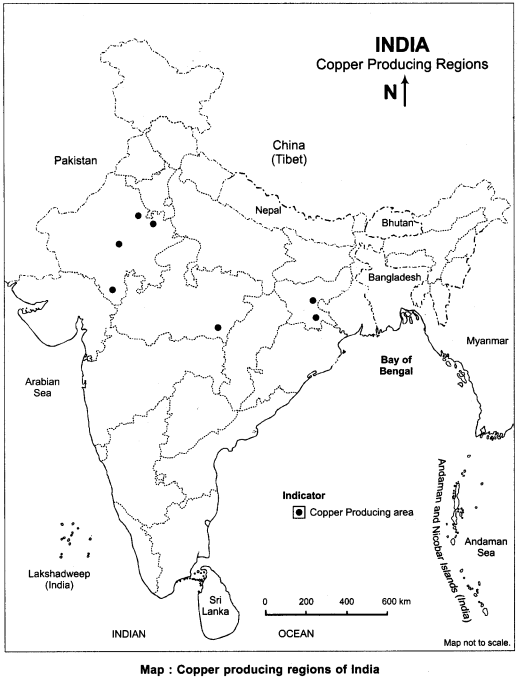
RBSE Class 12 Geography Chapter 16 Short Answer Essay Type Questions
Question 1.
Describe the animal rearing regions of India.
Answer:
Livestock is a major occupation in rural areas of India. Following are the major animal rearing regions of India:
1. Himalayan Mountainous Region:
In this animal rearing area, Uttarakhand, Himachal Pradesh and Jammu – Kashmir and Himalayan terai region and north – eastern states are included. Due to being a mountainous region, sheep and goats are major domesticated animals. Sheep are reared for good quality white coloured woolen. The tendency of rearing milch animals has increased in some region due to significant development taking place in the Tourism sector.
2. North – Western Arid and Semi – Arid Cimatic Regions:
This animal rearing region is spread in the Thar Desert and around it in the extended arid and semi – arid regions in which Punjab, Haryana, Western Uttar Pradesh, Rajasthan, Western Central region and Western Gujarat are included.
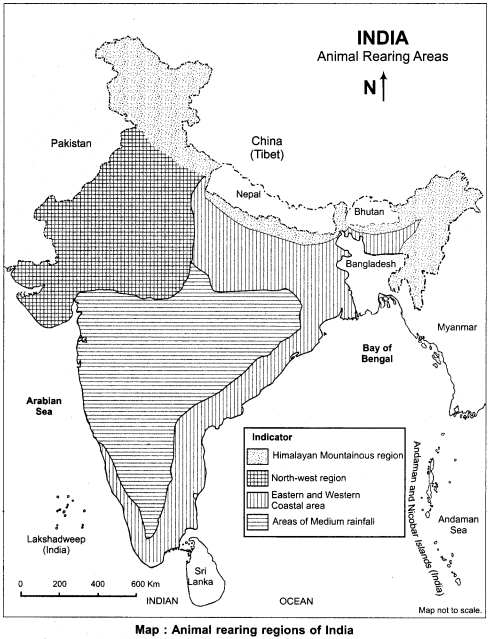
Due to scarcity of rainfall, in place of agriculture, occupation of animal rearing is mainly done in these regions. Wheat is grown,in the irrigated regions of this animal rearing region and the chaff of wheat is used as fodder for animals. Sorghum and millet is grown during the rainy season, and its chaff is also used as animal fodder. Camel, sheep, buffalo, cow, goat, horse, mule and donkey are major animals reared in this region.
3. Eastern and Western Coastal Regions:
Eastern Uttar Pradesh, Bihar, West Bengal, Asom, Odisha, Andhra Pradesh, Eastern Tamil Nadu and the western sea coast belt of Kerala is included in this animal rearing region. Suitable conditions for cultivation of rice are found here. Haulm straw of rice and lea are major fodder for animals. Buffalo is the major milch animal reared here while oxens are used in agricultural activities.
4. Regions of Medium Rainfall:
Southern Uttar Pradesh, Madhya Pradesh, Western Andhra Pradesh, Western Tamil Nadu, Karnataka and Eastern Maharashtra state are included in this animal rearing region. Being a region of medium rainfall, Sorghum and millet are major agricultural crops. Sheep is the major animal reared which provides inferior quality of wool. In regions where irrigation facilities of tube wells and other sources are available, high breed varieties of cows and buffalos are reared there.
Question 2.
Write a note on the major animals domesticated in India.
Answer:
Total number of dometicated animals was 51.21 crore in India in 2012. Cow – ox, buffalo, goat, sheep and camel are major domesticated in India.
1. Cows and Ox:
India is at the second place after Brazil in the world’s cow and ox rearing countries. In 2012, total number of cows and oxen in the country was 19.1 crore, which is 12.7% part of the total number of cows and oxen in the world. The milk of cows of Indian species is the best in the world and is of A2 category. Cows and oxen are reared in most parts of India. Cow milk is regarded as amrit for health due to its excellent quality and nutritive values.
2. Buffalo:
India is at the first place in buffalo rearing countries of the world. In 2012, the approximate total number of buffaloes was 11 crore in India, which is 56.7% part of the total number of buffaloes in the world. Due to the requirement of relatively colder climate and more water, buffaloes are mostly reared in wet regions.
Uttar Pradesh, Andhra Pradesh and Maharashtra are major buffalo rearing states of India, while Punjab, Haryana, Rajasthan, Madhya Pradesh, Chhattisgarh, Jharkhand, Bihar and Tamil Nadu are other buffalo rearing states. As compared to cow, buffalo provides more milk and its milk contains more fat, is nutritious and is more thick.
3. Goat:
Goats are reared in India for milk and meat production. Cost of their maintenance is low and they rapidly increase in number. 13.5% crore goats are there in India, which is 14.5% part of the total number of goats (at the first place in the world) in the world. Rajasthan, Uttar Pradesh, Punjab, Gujarat, Madhya Pradesh, Tamil Nadu, Andhra Pradesh and Jharkhand are major goat rearing states of India.
4. Sheep:
India is at the second place after China in sheep rearing countries of the world. Amost 65 crore sheep are reared in India. In India, sheep is mainly reared to obtain wool and meat. Sheep rearing is the major source of livelihood in arid, semi – arid and mountainous parts of the country. Almost 60% sheep of the country are reared in Rajasthan, Andhra Pradesh, and Tamil Nadu states.
Madhya Pradesh, Karnataka, Himachal Pradesh, Punjab, Haryana, Uttarakhand and Uttar Pradesh are other states of the country in terms of sheep rearing. Inferior quality of wool is obtained from Indian sheep which is mainly used to make carpets.
Question 3.
Show major river basins on the map of India.
Answer:
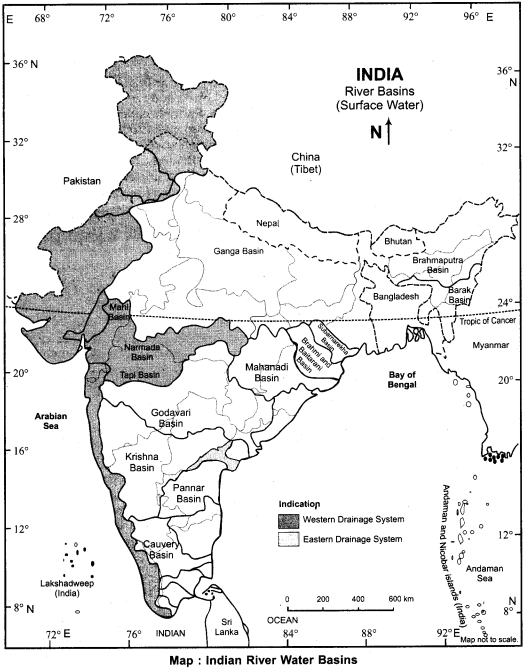
Question 4.
Describe major measures of water conservation and management.
Answer:
Following are the major measures of water conservation and management:
1. Solution of water pollution:
Due to increasing activities of human, a rapid decline in water quality has been seen. For improving water quality, emphasis should be given on use of bio manure in place of chemical fertilizers. Along with this, polluted water should be purified using advanced technique and this purified water should be used in agricultural works and recycling of polluted water from industries should be done.
2. Recycling and Reuse of of water:
Through modern technique of water recycling and use, availability and quality of non-saline water can be improved. Along with this, low quality purified waste water can be used in refrigeration and air conditioning, fire exhaustion, bathing, cleaning of utensils and washing of vehicles.
3. Water feed Management:
Water feed management refers to the proper management mainly of rain water, surface water and underground water. Under this, collection of water flowing on the surface of dams, lakes and ponds, and collection and recharge of underground water in recharge wells are included.
Central government, state governments and NGOs of India are running programmes of water feed development and management in vrious parts of the country, in which Haryali Jal Sambharan Vikas Pariyojna is the major one. Apart from this, through Aravari Water Parliament in Alwar district of Rajasthan, Neeru – Meeru (water and you) scheme in Andra Pradesh, ponds, pools and dams have been built by public support. In Tamil Nadu, building of water collection structure during construction of houses has been made mandatory.
4. Rain water Harvesting:
The process of stopping and collecting rain water for various uses is known as rainwater harvesting. This method is used to recharge underground water repositories. Through this method, rain water is collected in pits, ponds, wells and man – made underground tanks due to which underground water level increases. In India, rain water is collected in lakes, ponds, pools and tanks in traditional form.
Question 5.
Give a description of regions of mica deposits and production in India.
Answer:
Regions of Mica Deposits:
India is at the first place in Mica producing countries of the world and almost 80% of mica mining of the world is done here every year. According to United States Geological Survey, in 2013, China was at the First place, Russia was at the second place and India was at the third place in mica producing nations of the world. Jharkhand and Tamil Nadu are major states of mica production in India.
1. Andhra Pradesh:
Andhra Pradesh is at the first place in the mica – producing states of India. Around 70 to 75 per cent of total mica production of the country is done in this state. Visakhapatnam, Krishna, Eastern Godavari, Western Godavari, Khammam and Anantpur are major mica producing districts of the state. Mica mines situated in Nellore is famous for high quality in the entire world. Green – coloured mica is produced in this state.
2. Rajasthan:
Rajasthan is at the second place in mica producing states of India. 12 to 18 per cent mica production of India is done in this state per year. Bhilwara, Udaipur, Ajmer and Rajsamand are major mica producing districts of the state. Tonk, Alwar, Bharatpur and Dungarpur are other minor mica producing districts of this state. High quality light green and pink coloured mica is produced in the state of Rajasthan.
3. Jharkhan – Bihar:
Both these states contribute almost 10 to 12 per cent in total mica production of the country. Hazaribagh, Kodarma, Bhagalpur, Munger and Santhal Pargana are the major districts of mica production. Here, mica named Bengal Manik is found, which is light red in colour and is high quality of mica.
4. Tamil Nadu:
Thirunelvelli, Coimbatore, Madurai and Thiruchirappalli are major districts of mica production in the state.
Other States:
- Kerala – Nayyur, Punnalur, Quilon districts.
- Odisha – Dhenkanal, Sambalpur, Koraput, Cuttak and Ganjam districts.
- Karnataka – Hassan and Mysore districts.
- Chhattisgarh – Bastar districts.
- West Bengal – Bankura and Midnapur districts.
- Haryana – Gurugram district.
Production:
Huge decline in mica demand has taken place at world level due to increasing use of substances such as plastic in the form of substitute of mica in the electronics industry due to which mica production in India has increased at slow pace. 1217 tons of mica was produced in 2003 – 04, 1300 tons was produced in 2007 – 08 and 1610 tons of mica was produced in 2013 – 14. Mica production areas of India are shown by this map:
